What is Enterprise Application Integration (EAI) & How it Works?
Summarize this article with:
✨ AI Generated Summary
Enterprise application integration (EAI) is essential for synchronizing data across multiple systems, eliminating silos, and enabling unified, high-quality datasets that drive informed decision-making. Modern EAI frameworks leverage AI for automated workflows, predictive analytics, and dynamic optimization, while addressing challenges like scalability, security, legacy system integration, and compliance through zero trust architectures and governance automation. Key architectural patterns include hub-and-spoke, ESB, middleware, and microservices, supported by platforms like Airbyte and Azure Integration Services that offer extensive connectors, real-time synchronization, and enterprise-grade security.
Enterprise application integration has become critical for organizations managing exponentially growing data volumes across disparate systems. Modern enterprises operate an average of 37 distinct data repositories requiring synchronization, creating governance blind spots and integration bottlenecks that consume 30-50 engineers just to maintain basic pipeline operations.
When customer transaction data resides in your CRM while inventory levels live in your ERP and marketing analytics exist in separate platforms, you face the impossible choice between expensive legacy integration solutions or complex custom development that diverts engineering resources from business value creation.
Enterprise application integration addresses this fundamental challenge by connecting different applications, databases, and data systems across departments to enable seamless data movement and centralized analysis.
Rather than accepting data fragmentation as an operational reality, modern EAI frameworks transform integration infrastructure from a cost center into competitive advantage through automated workflows, real-time synchronization, and governance-by-design principles.
What Are the Core Concepts and Benefits of Enterprise Application Integration?
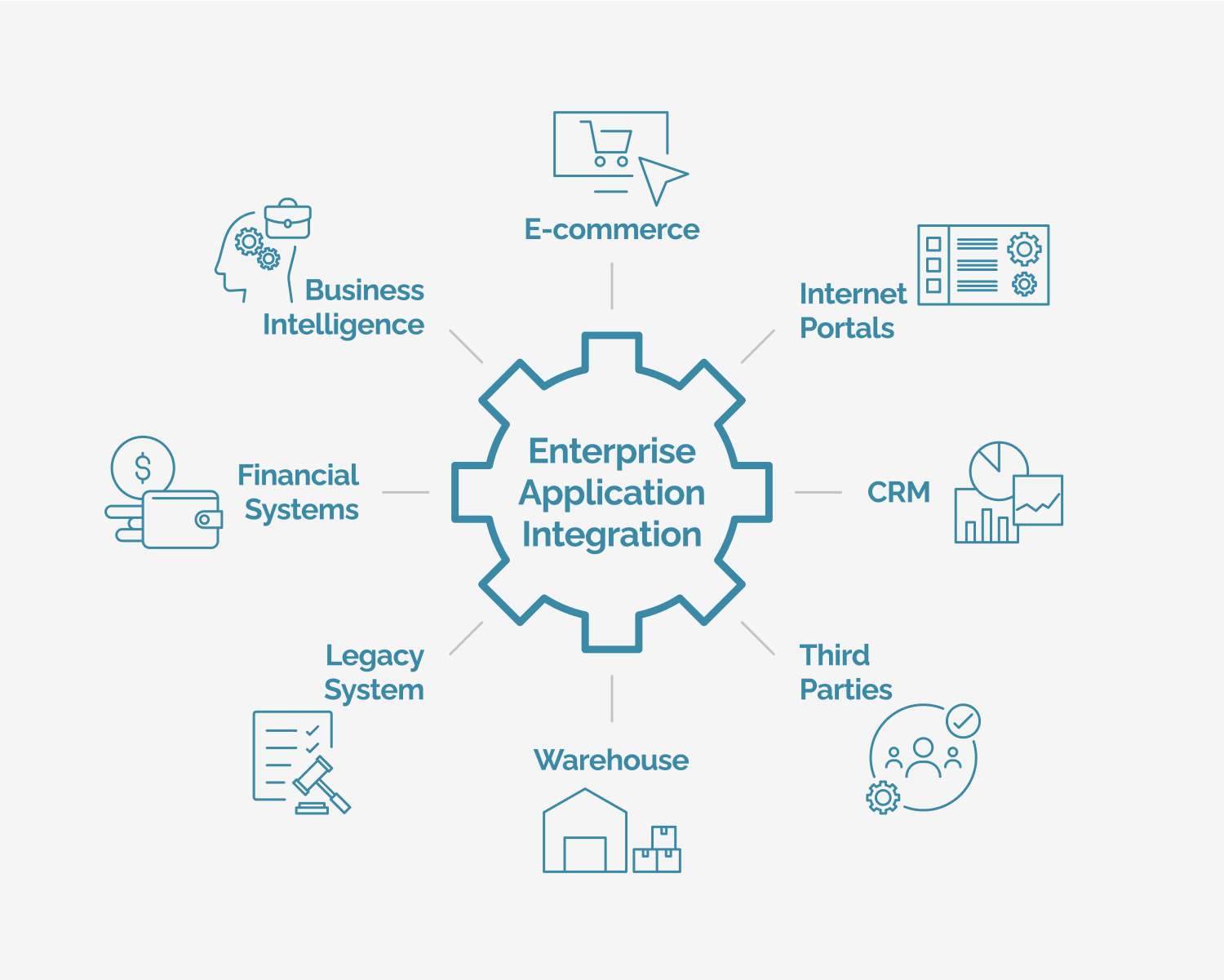
Enterprise application integration represents the strategic process of connecting applications, databases, and data systems across organizational departments to enable unified data operations. This integration eliminates the data silos that naturally emerge when different departments deploy specialized software solutions for their unique operational requirements.
Common enterprise applications include customer relationship management (CRM) platforms, enterprise resource planning (ERP) systems, payroll processing software, marketing automation tools, and industry-specific applications tailored to particular business functions.
The fundamental value proposition of enterprise application integration extends beyond simple data connectivity. Modern EAI frameworks create intelligent data ecosystems where information flows automatically between systems while maintaining data quality, security, and governance standards.
This transformation enables organizations to move from reactive data management approaches toward predictive, data-driven decision-making capabilities that respond to market changes in real-time.
Strategic Business Advantages
Consistency and High-Quality Data
Unified data obtained through EAI provides greater consistency across organizational touchpoints, enabling transformation processes that create high-quality enterprise datasets. These consolidated datasets support more accurate analytics and facilitate well-informed decision-making processes that directly drive business growth.
Data validation rules applied during integration prevent inconsistencies from propagating across systems, ensuring reliable information for critical business processes.
Breaking Down Data Silos
Enterprise application integration eliminates data silos by establishing centralized repositories that multiple departments can access and utilize for coordinated workflows. Marketing teams can access real-time customer data from sales systems, while finance departments can synchronize with operations for accurate reporting and planning.
This interconnectedness reduces redundant data entry, minimizes communication delays, and enables cross-functional teams to work with shared, accurate information.
Unified Customer Intelligence
EAI enables comprehensive customer data unification by connecting marketing, sales, and customer service platforms. Organizations can leverage this integrated customer intelligence to develop sophisticated marketing strategies, identify customer preferences with greater precision, and create personalized product experiences that increase satisfaction and loyalty.
Customer service representatives access complete customer histories across all touchpoints, enabling more effective query resolution and relationship management.
Optimized Operations and Efficiency
By integrating enterprise applications, organizations reduce the operational overhead of maintaining duplicate data across multiple systems while gaining insights that optimize resource allocation. Integration of inventory and sales data prevents costly overstocking and understocking situations, while unified financial data enables more accurate budgeting and forecasting.
The automation capabilities inherent in modern EAI platforms reduce manual data processing tasks, freeing personnel for higher-value activities.
What Are the Primary Challenges in Implementing Enterprise Application Integration?
Modern enterprise application integration projects encounter several critical challenges that require strategic planning and technical expertise to address effectively.
Scalability and Performance Management
The integrated data systems created through enterprise application integration often contain massive datasets that grow exponentially with business expansion. As organizations scale, these systems may struggle to accommodate increased data volumes, resulting in degraded performance that impacts business operations.
Modern cloud-native integration platforms address this challenge through auto-scaling architectures and distributed processing capabilities that maintain performance regardless of data volume fluctuations.
Comprehensive Security and Compliance Requirements
Integrating multiple applications and databases creates expanded attack surfaces that can expose organizational data to security breaches and compliance violations. The interconnected nature of integrated systems means that vulnerabilities in one application can potentially compromise entire data ecosystems.
Organizations must implement robust security frameworks including role-based access control (RBAC), end-to-end encryption, and comprehensive audit logging.
Regulatory compliance frameworks such as GDPR, HIPAA, and SOX require specialized controls for cross-system data flows, making security architecture a critical component of successful EAI implementations.
Technical Integration Complexity
Different databases, applications, and data systems employ varied architectures, data formats, and communication protocols that complicate integration efforts. Legacy systems may use outdated data structures or proprietary formats that require specialized transformation logic, while modern cloud applications employ API-based interfaces with different authentication and rate-limiting mechanisms.
Managing this technical heterogeneity demands sophisticated mapping and transformation capabilities that can handle schema evolution and data format variations across integrated systems.
Legacy System Integration Barriers
Organizations with established legacy data systems face particular challenges integrating older applications with modern third-party software products and cloud-based APIs. Legacy systems may lack modern integration interfaces or employ deprecated communication protocols that require specialized adapters or middleware solutions.
These integration barriers can significantly increase project complexity and cost while limiting the real-time data exchange capabilities that modern business processes demand.
How Does Modern Enterprise Application Integration Architecture Function?
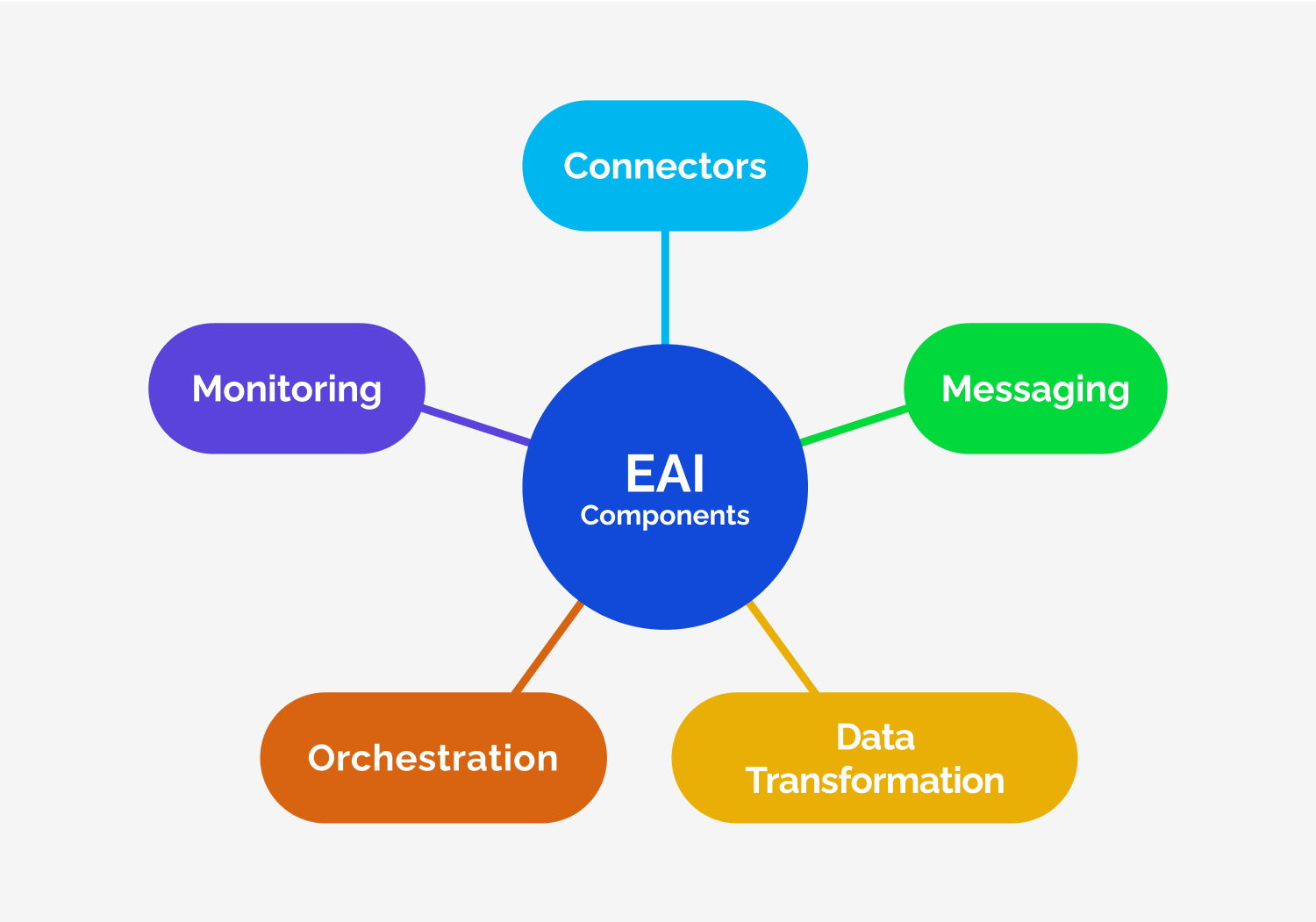
Discovery and System Inventory
Modern enterprise application integration operates through sophisticated workflows that orchestrate data movement across complex system landscapes while maintaining quality, security, and performance standards. Integration architects conduct thorough discovery processes to catalog every application, database, flat file system, and data warehouse across all organizational departments.
This inventory includes both obvious systems like primary ERP platforms and hidden data sources such as departmental spreadsheets or legacy applications that contain critical business information. Teams then identify target systems where consolidated data will reside, considering factors such as query performance requirements, regulatory compliance needs, and analytical capabilities.
Data Extraction Mechanisms
Advanced extraction mechanisms pull data from identified source systems using optimized techniques tailored to each system's characteristics. Database sources may employ change data capture (CDC) for real-time synchronization, while API-based systems utilize scheduled polling or webhook-driven extraction methods.
Extracted data can be staged in temporary storage systems such as AWS S3, Google Cloud Storage, or Azure Blob Storage to enable parallel processing and provide recovery capabilities during complex transformation operations.
Transformation Engines
Data transformation engines convert information into formats compatible with destination systems while applying business rules, data quality checks, and enrichment processes. These transformations handle schema mapping, data type conversions, field validations, and business logic applications that ensure data consistency across integrated systems.
Modern transformation frameworks support both real-time stream processing and batch-based transformations depending on business requirements and system constraints.
Routing and Distribution Layers
Integration layers employ sophisticated routing engines with pre-defined business rules and workflows that determine optimal data distribution paths. These systems consider factors such as data sensitivity, processing priority, system availability, and resource utilization when making routing decisions.
Advanced routing capabilities include load balancing across multiple destination systems, failover handling for system outages, and conditional logic that adapts data flows based on content characteristics or business events.
Data Loading Processes
Final loading processes move transformed data into chosen destination systems using optimized techniques that maximize performance while maintaining data integrity. Loading strategies may include bulk operations for large datasets, micro-batch processing for near-real-time updates, or streaming inserts for continuous data flows.
Modern loading processes incorporate error handling, data validation, and rollback capabilities that ensure consistent system states even during unexpected failures or data quality issues.
What Are the Various Enterprise Application Integration Architectural Patterns?
Most contemporary EAI implementations leverage centralized hub architectures, but several patterns address different organizational requirements and technical constraints.
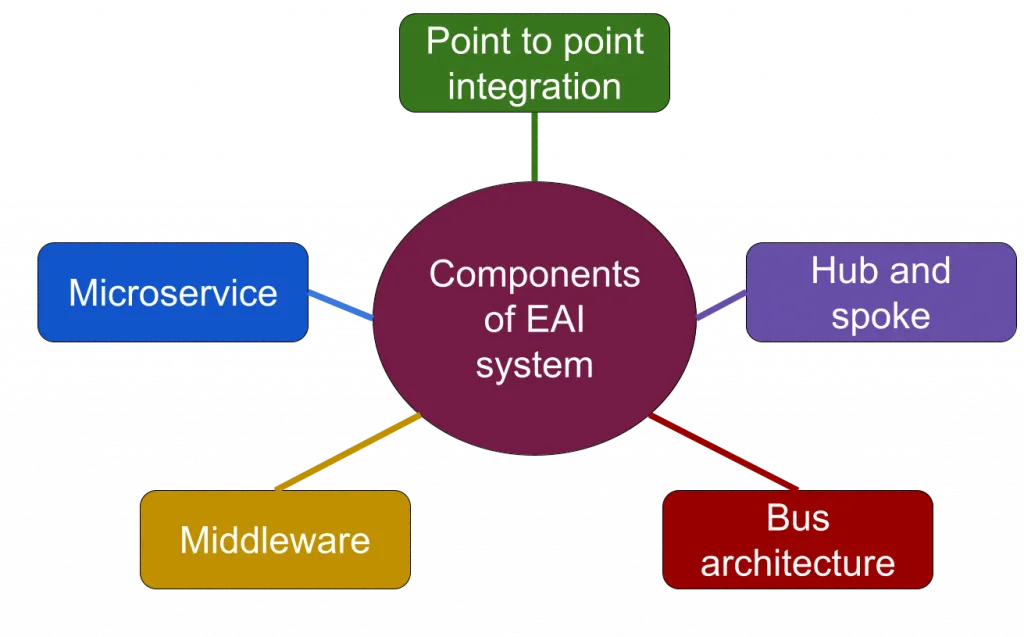
Direct Point-to-Point Integration
Point-to-point integration establishes direct data transfer connections between two specific endpoints without intermediate processing layers. This approach works effectively for organizations with limited application sets but quickly becomes unmanageable as system complexity increases.
Each additional application requires dedicated connections to every other system, creating maintenance overhead that grows exponentially with the number of integrated systems.
Centralized Hub and Spoke Architecture
Hub and spoke patterns route all application connections through a centralized processing hub where data transformations, validations, and routing decisions occur before distribution to destination systems.
The hub and spoke model provides better scalability than point-to-point approaches while enabling centralized governance and monitoring capabilities. However, the central hub represents a potential single point of failure that requires robust high-availability design and disaster recovery planning.
Enterprise Service Bus Frameworks
Enterprise Service Bus (ESB) architectures extend hub and spoke patterns with additional sophistication and reliability features that support complex integration scenarios.
Integration Endpoints function as standardized entry and exit points with unique addresses that enable consistent communication protocols across diverse applications and systems.
Protocol Adapters translate messages between different formats and communication protocols while providing logging, error handling, and monitoring capabilities that ensure reliable data exchange.
Message Bus Infrastructure transports and routes messages based on configurable business policies, enabling dynamic routing decisions and load balancing across multiple destination systems.
Middleware-Based Integration
Middleware solutions provide intermediary layers that connect applications with incompatible interfaces or communication protocols. These platforms can implement ESB architectures, hub and spoke patterns, message-oriented middleware, or application-server middleware depending on specific integration requirements.
Middleware platforms excel at handling complex protocol translations and providing abstraction layers that simplify application connectivity.
Microservices Integration Patterns
Microservices architectures decompose monolithic applications into independent services that communicate through well-defined APIs and messaging interfaces. While individual microservices may employ point-to-point or ESB communication patterns, the overall architecture provides greater flexibility and fault tolerance through service independence.
Integration between microservices typically relies on event-driven patterns and API gateways that manage cross-service communication and security.
How Can AI-Powered Integration Automation Transform Enterprise Data Operations?
Artificial intelligence has evolved from a supportive technology to the central engine driving next-generation integration platforms, fundamentally transforming how organizations approach data connectivity and orchestration.
Modern AI-driven integration frameworks employ neural networks that analyze data flows across hybrid environments, automatically generating transformation rules and mapping relationships with remarkable accuracy rates exceeding ninety percent in controlled deployments.
Neural Integration Engines and Machine Learning Orchestration
Contemporary integration platforms embed sophisticated AI engines that learn from data flow patterns and automatically optimize pipeline configurations without manual intervention. These systems employ reinforcement learning algorithms to analyze payload routing performance, dynamically adjusting pathway selections to reduce latency and improve throughput.
Machine learning models integrated directly into middleware platforms can interpret natural language integration requirements, automatically generating the necessary data pipelines and transformation logic that adapt to schema changes as they occur.
Intelligent Data Orchestration and Predictive Analytics
Beyond reactive data processing, AI-powered integration platforms anticipate operational requirements through temporal pattern analysis and predictive modeling. These systems analyze historical data flows, seasonal business patterns, and real-time performance indicators to forecast integration resource needs and automatically provision additional processing capacity before demand peaks occur.
Predictive orchestration significantly reduces integration-related downtime by identifying potential failure points and implementing preventive measures.
What Are the Critical Security and Governance Frameworks for Modern Enterprise Integration?
Modern enterprise application integration environments face unprecedented security challenges stemming from expanded attack surfaces, complex regulatory requirements, and sophisticated threat actors targeting interconnected systems.
Organizations must implement comprehensive security frameworks that protect data throughout its journey across integrated systems while maintaining the performance and accessibility that business operations demand.
Zero Trust Integration Architecture and Continuous Verification
Zero Trust Architecture has become the foundational security framework for contemporary EAI implementations, eliminating implicit trust assumptions through continuous verification of every system interaction and data access request.
This approach requires micro-segmentation of integration points, creating security perimeters around individual transaction pathways and data flows. Advanced implementations employ behavioral analytics that establish dynamic access baselines, continuously monitoring user and system behavior patterns to identify potential security anomalies or unauthorized access attempts.
Modern Zero Trust integration frameworks incorporate AI-powered threat detection systems that analyze network traffic patterns in real-time, identifying subtle behavioral changes that may indicate compromised credentials or lateral movement attempts within integrated environments.
These systems implement just-in-time access controls that dynamically adjust permissions based on contextual risk scoring, temporarily elevating privileges during high-validation transactions while maintaining least-privilege defaults for routine operations.
Cryptographic Protection and Advanced Authentication
Transport Layer Security (TLS) 1.3 implementation forms the cryptographic foundation for secure data exchange between integrated systems, with forward secrecy protocols preventing decryption of captured traffic after session termination.
Advanced implementations leverage mutual TLS (mTLS) for service-to-service authentication within integration layers, requiring both client and server certificate validation before establishing communication channels.
Emerging cryptographic approaches include confidential computing techniques that maintain data encryption during processing operations, rendering data unreadable even to system administrators or potential attackers with privileged access.
These advanced protection mechanisms enable privacy-preserving analytics across integrated systems without exposing raw data, allowing organizations to derive business insights while maintaining strict data protection standards.
Governance Automation and Compliance Framework Integration
Modern data governance frameworks automate policy enforcement through active metadata layers embedded within integration pipelines, automatically classifying data assets and applying access controls based on predefined regulatory requirements.
These systems provide comprehensive audit logging and data lineage tracking capabilities that support regulatory compliance while enabling rapid forensic analysis during security investigations.
AI-augmented governance platforms continuously monitor integration activities for policy violations, automatically blocking non-compliant data transfers while generating detailed audit trails for compliance reporting.
Advanced implementations incorporate privacy-enhancing technologies such as differential privacy and homomorphic encryption that enable collaborative analytics while preserving individual data privacy and meeting regulatory requirements for data protection.
What Should Organizations Consider Before Implementing Enterprise Application Integration?
Successful enterprise application integration requires comprehensive planning that addresses technical requirements, business objectives, and organizational readiness factors that determine project outcomes.
Establishing Clear Business Objectives and Success Metrics
Organizations must define specific, measurable goals that align integration initiatives with strategic business outcomes rather than pursuing technology implementation for its own sake. Effective objectives include improving analytical capabilities through unified data access, enhancing cross-departmental data sharing to reduce operational silos, or streamlining workflows to eliminate redundant manual processes.
Success metrics should encompass both technical performance indicators such as data quality scores and integration reliability, as well as business impact measures including time-to-insight improvements and operational cost reductions.
Comprehensive Data Mapping and Schema Alignment
Thorough data mapping exercises identify field relationships across integrated systems, ensuring accurate data alignment and transformation logic. This process involves mapping corresponding data elements such as customer identifiers in CRM systems to customer numbers in ERP platforms, while accounting for differences in data formats, validation rules, and business logic.
Effective data mapping also addresses schema evolution scenarios, establishing processes for handling structural changes in source or destination systems without disrupting established integration workflows.
Robust Security Architecture and Compliance Framework
Security planning must address the expanded attack surfaces created by system integration, implementing comprehensive protection mechanisms including end-to-end encryption, role-based access controls, and multi-factor authentication systems.
Organizations operating in regulated industries must ensure compliance with applicable frameworks such as GDPR, HIPAA, or SOX through specialized controls for cross-system data flows and comprehensive audit capabilities. Regular security assessments and penetration testing validate the effectiveness of implemented security measures while identifying potential vulnerabilities before they can be exploited.
Performance Monitoring and Optimization Strategies
Continuous monitoring systems track critical performance metrics including response times, error rates, data throughput, and system availability to identify bottlenecks and optimization opportunities.
Effective monitoring encompasses both technical infrastructure metrics and business process indicators that measure the impact of integration on organizational operations. Performance optimization strategies should include automated scaling capabilities that adjust resource allocation based on demand patterns, as well as proactive maintenance procedures that prevent performance degradation over time.
Workforce Development and Training Programs
Successful integration implementations require workforce preparation that addresses both technical skills and process changes resulting from improved data accessibility. Organizations should assess current skill levels across relevant teams, design targeted training programs that address specific integration technologies and methodologies, and provide ongoing support through expert resources and comprehensive documentation.
Training programs should include practical, real-world use cases that demonstrate the business value of integration capabilities while building confidence in new tools and processes.
What Tools and Platforms Support Modern Enterprise Application Integration?
1. Airbyte
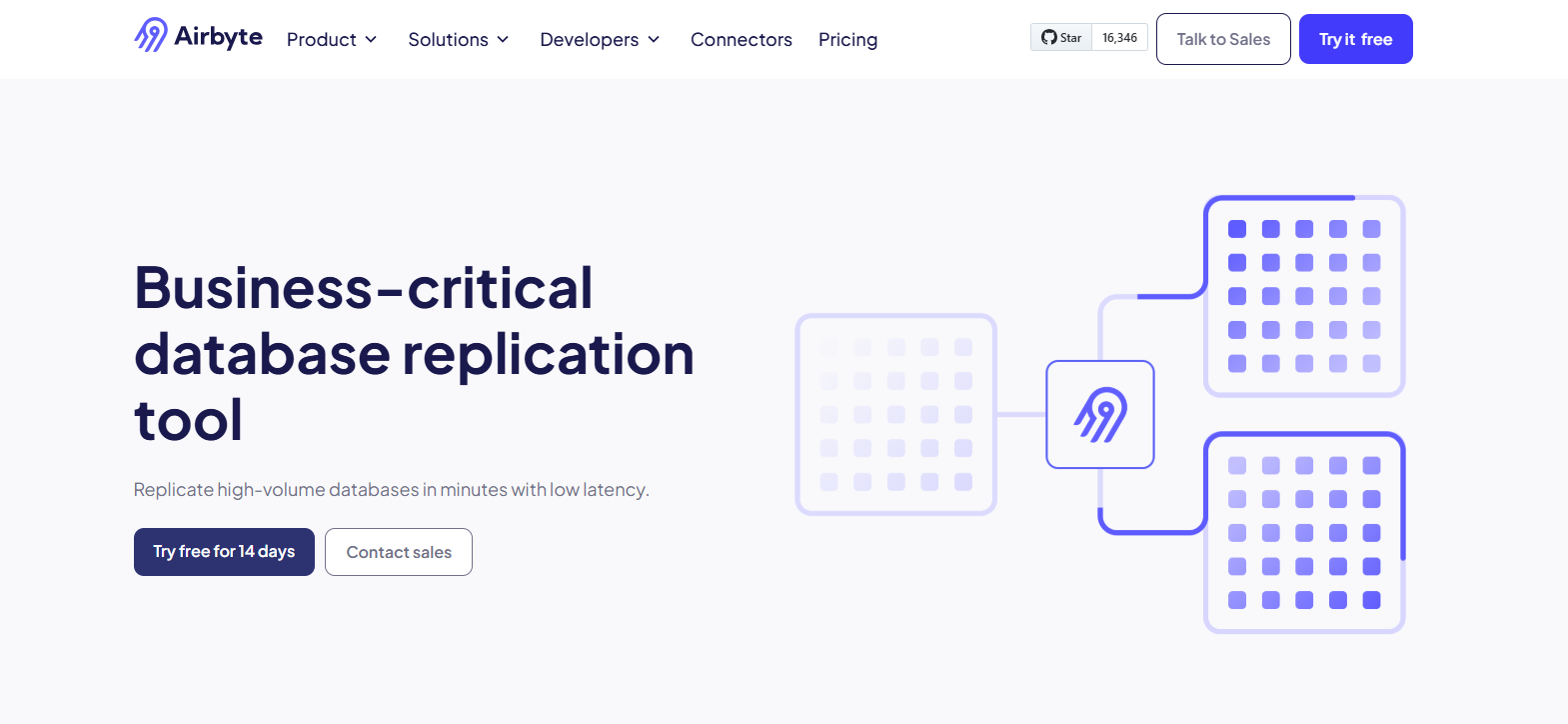
Airbyte represents the next generation of data integration platforms, combining open-source flexibility with enterprise-grade security and governance capabilities. The platform features over 600 pre-built connectors that eliminate custom development overhead while providing deployment flexibility across cloud, hybrid, and on-premises environments.
Advanced Connector Architecture
Airbyte's containerized microservices architecture enables unprecedented customization through multiple development approaches including the Connector Builder for no-code integration, Low-Code CDK for rapid customization, and full Python or Java CDKs for complex requirements. The AI-powered Connector Builder automatically generates configuration templates and provides intelligent suggestions that reduce integration development time from weeks to hours.
Enterprise Security and Governance Framework
The platform implements comprehensive security controls including end-to-end encryption, role-based access control integration with enterprise identity systems, and automated compliance capabilities for SOC 2, GDPR, and HIPAA requirements. Data lineage tracking and audit logging provide complete visibility into data movement across integrated systems while PII masking capabilities ensure compliance with data protection regulations.
Production-Scale Performance and Reliability
Airbyte processes over 2 petabytes of data daily across customer deployments while providing Kubernetes support for high availability and automatic scaling. The platform's change data capture capabilities enable real-time synchronization with sub-second latency, while automated schema management adapts to structural changes without manual intervention.
2. Azure Integration Services
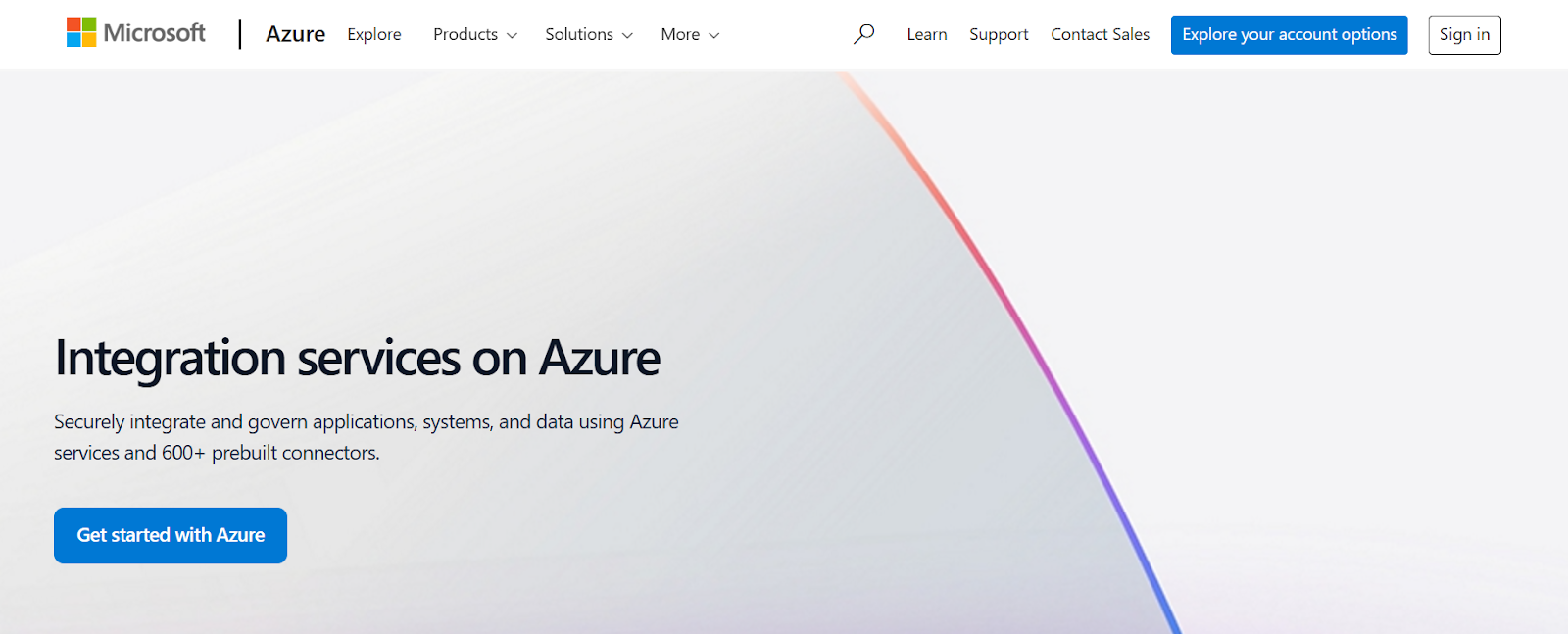
Microsoft Azure Integration Services provides comprehensive integration capabilities through a unified platform that combines over 600 connectors with Logic Apps, Azure Functions, and Data Factory services for end-to-end enterprise integration scenarios.
Event-Driven Integration Capabilities
Event Grid routes business events from multiple sources to appropriate destination systems with intelligent filtering and transformation capabilities. Service Bus provides reliable messaging workflows that connect cloud and on-premises applications with guaranteed message delivery and advanced routing features.
Hybrid Deployment and Connectivity Options
Azure integration services support hybrid architectures that span cloud and on-premises environments through secure connectivity options including virtual network integration and private endpoints. The platform provides specialized connectors for Microsoft ecosystem applications while maintaining compatibility with third-party systems and legacy applications.
3. Boomi
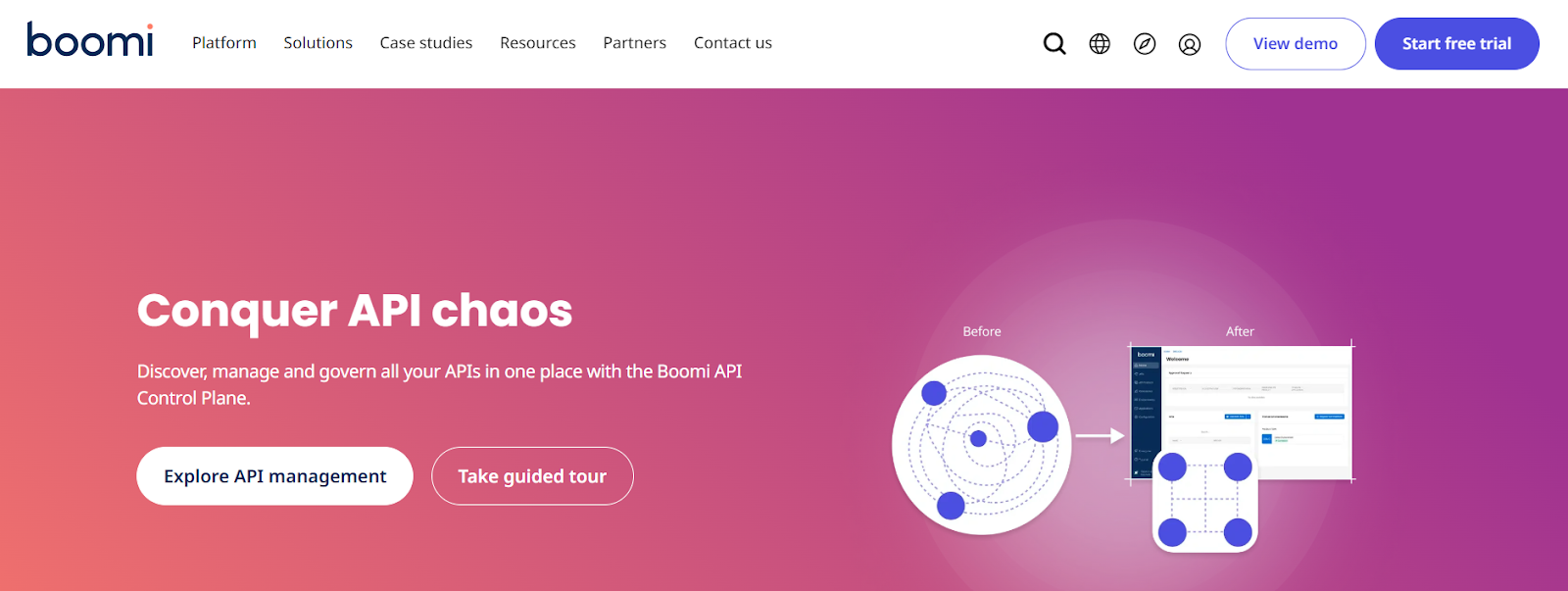
Boomi offers an integration Platform as a Service (iPaaS) solution with extensive connector libraries and deployment flexibility that supports complex enterprise integration requirements.
Boomi supports hybrid deployment models including cloud, on-premises, and edge configurations that enable organizations to maintain data residency requirements while leveraging cloud-native integration capabilities. The platform provides 99.99% uptime guarantees with detailed service level agreements and offline synchronization capabilities during outages.
The platform includes advanced monitoring and management tools that provide real-time visibility into integration performance, error handling, and data quality metrics. Built-in governance capabilities ensure consistent policy enforcement across all integration processes while supporting compliance requirements for regulated industries.
4. Workato
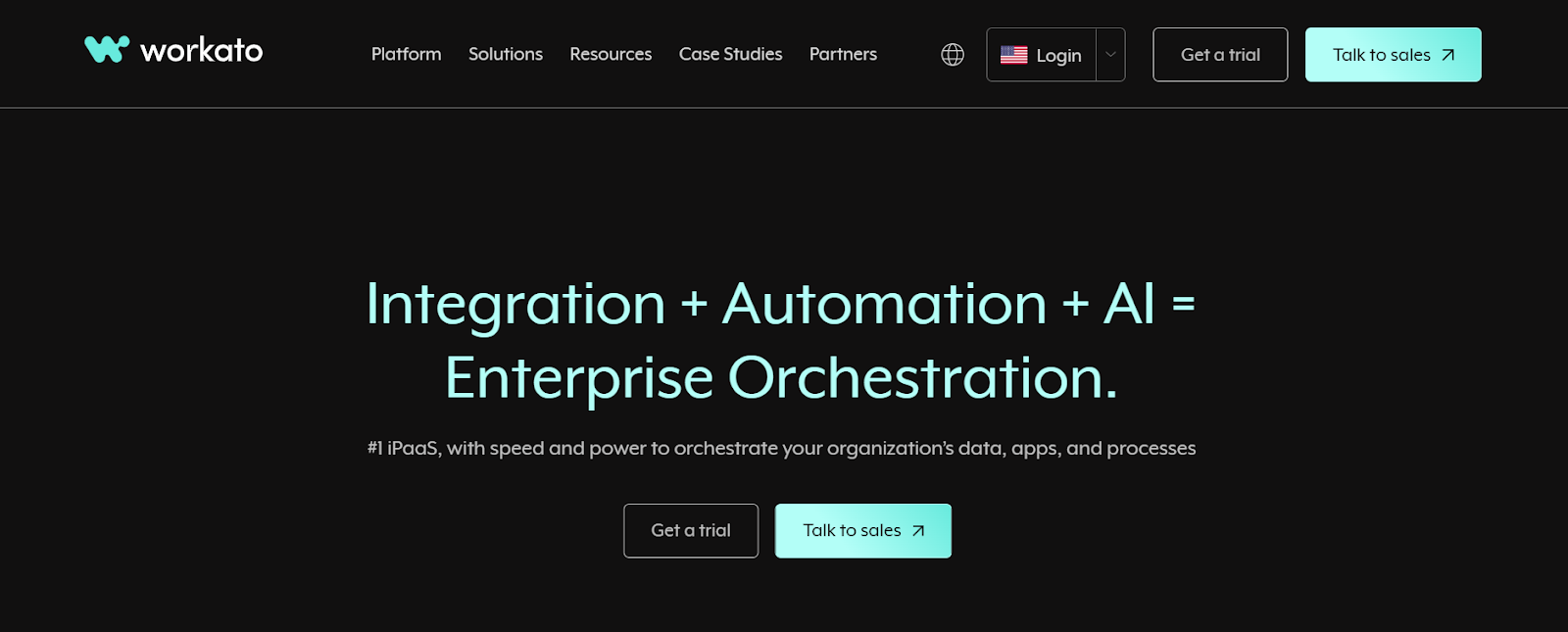
Workato provides a low-code automation and integration platform that uses intuitive "recipe" frameworks to simplify complex integration development while maintaining enterprise-scale capabilities.
Bot customization features enable organizations to build and deploy specialized automation agents such as HR bots or customer service bots that handle routine integration tasks. The platform's AI-powered suggestions accelerate recipe development by recommending optimal integration patterns based on similar use cases.
Robust versioning capabilities automatically track changes across integration workflows while providing comprehensive audit trails and rollback capabilities. Organizations can upgrade or modify integration processes without risking data loss or operational disruption through sophisticated change management features.
Conclusion
Enterprise application integration has evolved from a technical necessity into a strategic enabler that transforms data infrastructure from operational overhead into competitive advantage. Organizations that successfully implement modern EAI frameworks gain unprecedented visibility into business operations while reducing the engineering resources required to maintain data connectivity across complex application landscapes.
The convergence of AI-powered automation, sophisticated security frameworks, and flexible deployment options creates opportunities for organizations to democratize data access while maintaining rigorous governance standards. Contemporary integration platforms like Airbyte eliminate the traditional trade-offs between cost, flexibility, and control that historically constrained enterprise data strategies.
Success in modern enterprise application integration requires strategic alignment of technical capabilities with business objectives, comprehensive security planning that addresses expanded attack surfaces, and workforce development that enables organizations to leverage integrated data for competitive advantage.
Organizations that approach integration as an enabler of data-driven decision-making rather than a technical implementation challenge will realize the full potential of their data assets while building sustainable foundations for future growth and innovation.
Frequently Asked Questions (FAQs)
What is Enterprise Application Integration (EAI)?
Enterprise Application Integration (EAI) is the process of connecting different applications, databases, and systems across an organization to enable seamless data flow and unified operations. It eliminates silos, improves consistency, and ensures departments can work with accurate, shared information.
Why is EAI important for modern enterprises?
EAI is critical because most enterprises operate dozens of separate data repositories that must synchronize in real time. Without integration, data becomes fragmented, reporting is inaccurate, and workflows stall. EAI solves this by creating centralized, governed data flows that enable faster decisions and stronger collaboration.
What are the main challenges of implementing EAI?
Enterprises face challenges like handling massive data volumes at scale, ensuring security and regulatory compliance, and overcoming technical complexity from legacy systems and varied data formats. Successful projects require robust planning, secure architectures, and tools that support both legacy and modern platforms.
How does AI improve enterprise integration?
AI-powered integration platforms can automatically generate mapping rules, detect schema changes, optimize routing decisions, and predict performance bottlenecks. This reduces manual engineering effort and helps enterprises maintain real-time, resilient pipelines across hybrid and multi-cloud environments.

.webp)